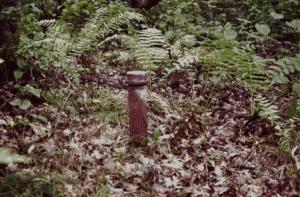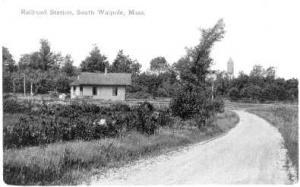The Late 1800's
As the Town of Walpole entered the 1890's, the town was becoming aware that the lack of a municipal water system was hindering the town's growth. As a result of these concerns, the Annual Town Meeting on March 7, 1892, directed that the Moderator appoint a 3 person committee to obtain information and estimates of the costs to develop a water works for the purpose of supplying the town with water for the purposes of extinguishing fires, manufacturing, and for domestic purposes. This committee was to report back at a future town meeting. The Moderator appointed Welyar W. Allen, Edmund Grover, and Charles Fales.
At the March 6, 1893 Annual Town Meeting, the 3 person committee submitted a favorable written report. The report was accepted by the town meeting and placed on file. The town meeting then voted to form a committee of 9 men, to be appointed by the Moderator, to fully consider the possibility of Walpole developing a municipal water supply. This committee was given $500 and was authorized to hire an engineer to assist them in their work. The committee was also instructed to petition the Massachusetts State Legislature for an Act authorizing the town to develop a water works and to issue the bonds necessary to construct such a system. The Moderator appointed Welzar W. Allen, Charles Fales, Charles Hartshorn, John A. Way, Robert L. Gray, Henry Plimpton, John F Ferne, James A. Robertson, and John B. Rooney to make up the Committee on Water Works.
The committee acted promptly to request an Act of the state legislature and on May 2, 1893, the State Legislature passed Chapter 277 of the Acts of the Legislature of Massachusetts for the year 1893. This Act authorized the town to build a water works and to issue the necessary bonds to construct that system.
The Committee on Water Work's next step was to hire E. W. Wothington as its engineer to assist them in their investigation of the development of a system of water works.
The Committee on Water Work's investigation determined that it was worthwhile for the town to pursue developing a water system. A Special Town Meeting was held on July 6, 1893 to act on the recommendations of the committee. These recommendations took the form of a series of 12 articles to establish a 3 person Water Commission, take land near the Lowe Brook (currently called School Meadow Brook), construct a water works, construct water services, and obtain the land surrounding the water works to protect the water supply. While the recommendations of the committee were accepted by the town meeting, the acceptance of the Act of the State Legislature failed to gain the necessary 2/3rds majority needed to go forth (102 voting yes, 87 voting no) and no action was taken on the rest of the articles.
Another effort was made at a Town Meeting held in February 1894 to get the town to accept the Act of Legislature, again the recommendations got a majority of favorable votes but failed to get the necessary 2/3rd's vote (111 voting yes, 105 voting no).
Finally at the November 12, 1894, Special Town Meeting, the Town Meeting gave the 2/3rd's vote to accept the Act of the State Legislature. Another Special Town Meeting was held on December 20, 1894 to vote on the rest of the articles to authorize the construction of the water works system. The Town Meeting also elected 3 Water Commissioners (at this time, the officials of the town were elected at town meetings). Elected were Thomas M. Crowley (a 1 year term), Arthur N. Cramm (for a 2 year term), and Henry P. Plimpton (for a 3 year term). The Water Commissioners were instructed to proceed with the construction of a water works. The Town Meeting also authorized the Board of Selectmen to borrow $2,500 for the Water Commissioners to take surveys, tests, and to take the necessary preliminary steps towards constructing a Water Works.
The Water Commissioners, immediately started looking for a supply of good quality water that would last the town for at least 25 years. The services of B. F. Smith and Bros. (Artesian Well drivers) were secured and wells were driven on the borders of the Cedar Swamp and at several other places without success. Attention turned to the vicinity of the Lowe Brook (now known as School Meadow Brook) and wells were driven on the land of Geo A. Plimpton (near Washington St.). Seven wells were driven with varying depths ranging from 40 to 60 feet. The results were excellent. Six of the wells were pumped for 6 days around the clock and found to yield 750,000 gallons per day without showing excessive drawdown of the groundwater near the wells. Samples of the water were sent to the Massachusetts State Board of Health and they reported back that the water was of good quality.
As a result of these positive results, the Water Commissioners felt justified in proceeding and at a Special Town Meeting, held on May 16, 1895, requested authorization to spend up to $100,000 to construct a water works, water mains, acquire lands, easements and water rights to construct a water system. The Town Meeting authorized the Water Commissioners to proceed and established a salary of $1,500 for the commissioners.
The Water Commissioners hired Freeman C. Coffin of Boston on June 7, 1895 to serve as construction engineer, to prepare plans and specifications, draw up contracts, and to inspect the materials and workmanship during the construction. The parameters were that the system was to consist of a driven well system near Lowe Brook, a pumping station, a standpipe (a water tank), street mains in excess of 15 miles, and to be completed for less than $100,000.
During the summer and fall of 1895, the construction of the water system progressed rapidly. Some of the contracts awarded were:
- M. J. Drummond of New York supplied the cast iron water mains for $22.35 per ton.
- Moore & Co. was contracted to lay the water mains for $14,958.21.
- Ludlow Valve Co. supplied the hydrants for $26.50 each.
- Davis & Farnum of Waltham Ma. built 2 standpipes (it was decided to construct a second standpipe to save money rather than use expensive large water mains to get water to South Walpole). The contracts were $2,950 for the standpipe located in East Walpole (still in existence on High Plain St.), and $3,838 for the elevated water tank in South Walpole off Summer St. (no longer in existence).
- Fuller & Gray built the foundations for the two standpipes and for the pumping station for $8114.
- George F. Blake Mfg. Co. was paid $7451 for the pumping machinery (one duplex condensing pump capable of pumping 1.5 million gallons, one one Underwriters Fire Pump capable of pumping 750 gallons per minute - a high pressure pump for emergency situations, and boilers, piping and air pumps).
- Hydraylic Constructions Co. of New York was paid $4,480 for the driven well system.
- Ransellaer Mfg. Co. supplied the gate valves for $11.15 to $30.00 per gate.
- P.S. Boyden built the pumping station for $1080.
By the end of 1895, most of the water system was completed. The system consisted of thirty four 2" driven wells and six 2 1/2" driven wells (these wells were open ended pipes, the bottom 2' of the pipes were perforated with holes to allow the water to enter).

These wells were approximately 40' apart connected by 2 1/2" wrought iron pipes to 6", 8", 10", and 14" suction mains. Each well could be shut off as could each line of wells. The well system was capable of producing 1,240,000 gallons per day. and was designed so it could be expanded. The suction system had an air pump to remove air from the lines (the system was fairly tight but air was able to be drawn into the system). The wells were connected to the suction lines by lead goosenecks to allow for the system to move when the ground froze and thawed. The pumping system consisted of one main pump and one emergency high pressure pump. these pumps were coal powered (there was no electricity at the pump station).

The distribution system consisted of 15.4 miles of water mains (6,957 ' of 12" main, 10,610' of 10" main, 27,825 of 8" main, and 35,931' of 6" main), 92 gate valves, and 108 hydrants. There were 2 standpipes, one in East Walpole on High Plain St. was 25' in diameter and 45' tall - this standpipe is still in use today), and an elevated tank in South Walpole on Summer St. (in the area between Shufelt Rd. and Eldor Dr.) - this tank was 20' in diameter, 35' tall, on a 45' tower.

There was a telemetering system that allowed the water levels in the tanks to be read in the pump station.
On January 15, 1896, the system began pumping water to the 110 services that were connected to the system. At it's beginning the following areas were served (primarily for fire protection initially):
- From the well field, the water main headed south on Washington St. to the elevated water tank in South Walpole on Summer St.
- From the well field, the water main headed north on Washington St. to Common St. where it headed to the center of town.
- From the center of town, the water main went north on Main St. to East St. where it then headed in 2 directions. One main continued north on Main St. to Plimpton St. to East St. The second branch headed east on East St. into East Walpole where it ran to the Bird factory (at the intersection of East St. and High Plain St., a line headed up High Plain St. to the water tank on High Plain St.).
Water was tested by the state once a year which has the ability to measure contaminates in parts per 100,000 (this contrasts with today where over 400 tests are performed each year and the sensitivity of some of the tests at the level of parts per billion). The water quality test checked for turbidity, sediment, color, odor, ammonia, chlorine, nitrates, nitrites, hardness, and iron.
The pump station operated by burning coal to heat water to create steam that ran the pumps. This meant that the pumping station required a fireman to keep the furnaces operating. Initial tests showed that the station was able to pump 355 gallons per pound of coal. The normal operation was for the pump station to operate during the day leaving the standpipes full at the end of the day, then coming in the next morning to start pumping again to refill the standpipes and to supply the water to be used during the day.

